New materials characterization facility enables over 350 multidisciplinary projects
By Sydney Goodfellow, Benjamin Hatton, Naomi Matsuura & RJ Taylor | Photos by Roberta Baker
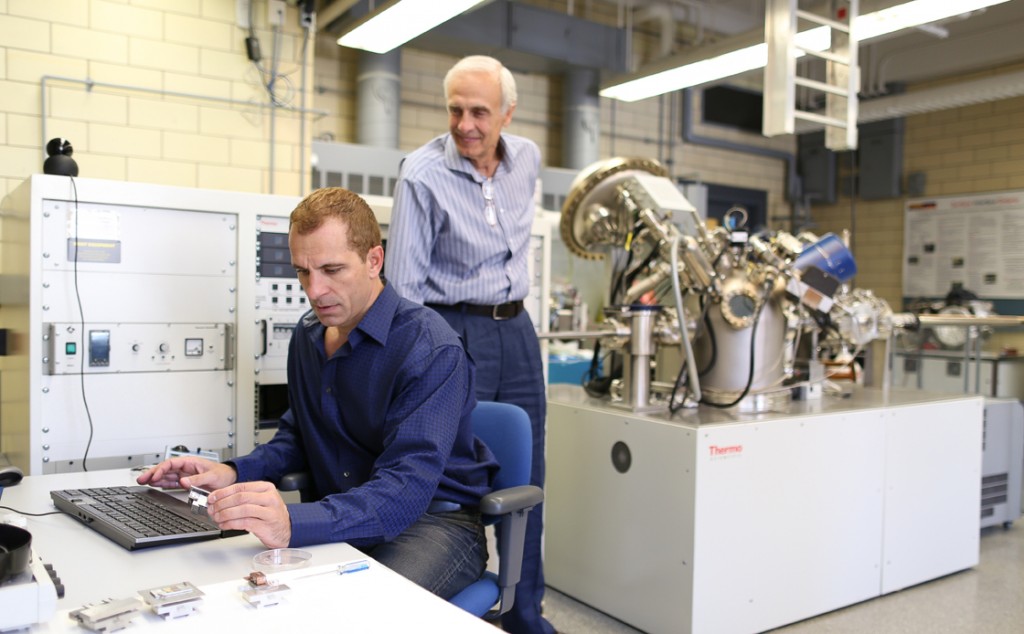
U of T Ontario Centre for the Characterization of Advanced Materials (OCCAM) co-principal investigators Professor Doug Perovic (MSE) and Professor Charles Mims (ChemE)
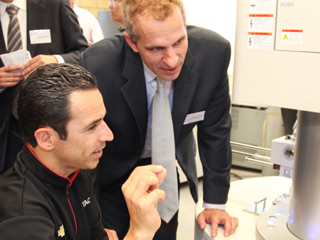 |
|
| Indy 500 champ Hélio Castroneves and Professor Doug Perovic use one of the electron microscopes to carve the OCCAM wordmark on a nano-scale ribbon at the July 17 unveiling event |
|
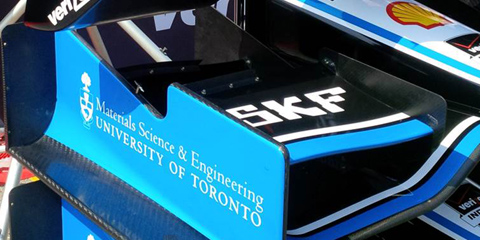 |
|
| U of T Materials Science & Engineering logo printed on Hélio Castroneves’ Hitachi-sponsored Penske Team race car for the 2014 Toronto Honda Indy, celebrating the partnership between U of T MSE and HHTC that led to the establishment of OCCAM (Photo by Khuong Doan) |
|
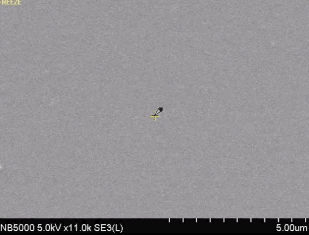 |
|
| OCCAM wordmark carved into a nano-scale ribbon 1,000 times smaller than a human hair |
|
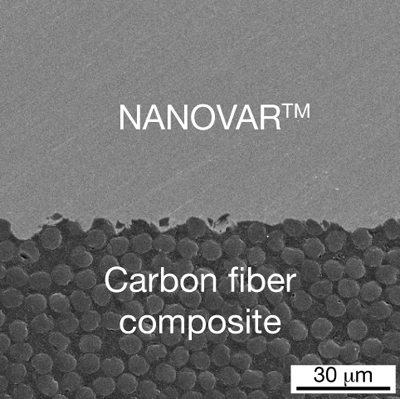 |
|
| Integran’s nanometal coating technology (Photo: Integran Technologies Inc) |
|
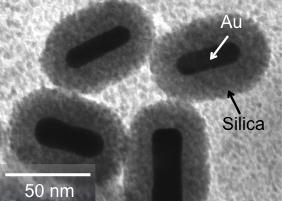 |
|
| Gold rod core nanoparticles with nanoporous silica glass shells for anti-cancer drug delivery (Photo: Naomi Matsuura) |
|
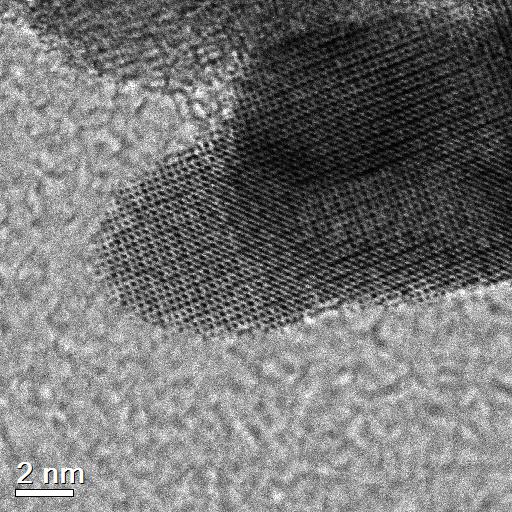 |
|
| Indium Oxide (In2O3) nanoparticle—a new generation of photocatalysis for solar fuels (Photo: Geoffrey Ozin, Laura Hoch) |
A light-weight, aerodynamic car speeds around the corner of a country road. The car’s metallic paint is composed of super strong nano-metals that—combined with high-impact, standard safety equipment—keep the passengers inside perfectly safe. That same paint is bonded with microscopic particles that use photosynthesis to manufacture fuel from sunlight—similar to plants—to keep the tanks full, all while cleaning harmful carbon dioxide from the air.
“These novel capabilities will allow us to chart new paths in engineering design.”
It sounds too good to be true, but innovative materials like these ones are currently in development at U of T’s new advanced materials lab, the Ontario Centre for the Characterization of Advanced Materials (OCCAM). Unveiled on July 17, 2014, the facility features state-of-the-art electron microscopes that allow researchers in energy, transportation, health care and more to develop safer, cleaner and more sustainable materials for a brighter future. Supported by the Canada Foundation for Innovation (CFI) and the Ontario Ministry of Research & Innovation (MRI) in partnership with Hitachi High-Technologies Canada (HHTC), OCCAM offers highly specialized tools to understand and manipulate matter at the atomic scale. The centre also emphasizes collaborative and multidisciplinary projects, anticipating over 350 different research programs annually involving engineers and scientists from academia and the private sector. The Faculty-wide facility is a joint initiative between the Department of Materials Science & Engineering (MSE) and the Department of Chemical Engineering & Applied Chemistry (ChemE).
“These novel capabilities will allow us to peer deeper into the inner space of materials and chart new paths for engineering design,” says Professor Doug Perovic (MMS 8T6, MASc 8T8, PhD 9T0), co-principal investigator for OCCAM alongside Professor Charles Mims (ChemE). “OCCAM is a shining example of how U of T Engineering, in partnership with industry and government, is pursuing innovative solutions to some of world’s greatest challenges in health, city life and energy,” says Dean Cristina Amon. “We are profoundly grateful to CFI, MRI and Hitachi for their contribution to the creation of this unique world-class facility.”
Three big (and small) ideas enabled by OCCAM
Car accidents that no longer kill people
“We have the technology today to make vehicles so safe that car accidents no longer kill people,” shares Professor Perovic. But if we have the means, why aren’t we using them? According to Perovic, the answer is cost—cost of materials and cost of manufacturing. That’s why, through OCCAM, he has partnered with Toronto-based Integran Technologies to develop newer, inexpensive methods of boosting vehicle safety and efficiency.
Integran is the only company in the world that can coat plastic and carbon fibre with nano-metals, allowing them to make virtually any material significantly stronger with one coating. While they are continuing to find ways of reducing cost, Integran’s technology has the potential for impact beyond the auto industry, from better spacecraft to lighter and more durable bicycles.
“The availability of OCCAM’s resources will significantly enhance our product development capabilities,” says Integran’s president and CEO, Dr. Gino Palumbo (MMS 8T3, MASc 8T5, PhD 8T9). “The added merit is that it’s located at U of T, an institution we’ve been in partnership with for many years and one of the main pipelines for our people talent.”
Nano-devices for imaging & treating cancer
Cancer is a fickle beast. Recent results show that patients with the same cancer type and tumour size can have highly variable patient-specific responses to cancer drugs, and that personalized therapy may lead to better outcomes and increased patient survival. However, despite decades of intense research and billions of dollars of investment in new, targeted therapies to help cure cancer, patient survival rates have not substantially improved.
“OCCAM’s microscopes will help us design better technologies for tumour imaging and hopefully—treatment.”
Assistant Professor Naomi Matsuura (MSE PhD 0T3) is leading a group at U of T’s Department of Medical Imaging to develop new injectable, nanoscale agents that will increase the effectiveness of existing personalized cancer drugs. As part of this initiative, her team synthesizes ‘model’ nanoparticles to help guide the design of new generation nanoscale agents for cancer imaging and therapy. These nanoparticles have a gold rod core and a nanoporous silica glass shell to contain anti-cancer drugs. When the gold is heated with imaging radiation, the drug can be released locally to target cancer cells.
“OCCAM’s high-resolution microscopes will allow us to see structures at the nanoscale and help us design better technologies for tumour imaging and hopefully—treatment,” says Matsuura.
Solar fuels—if trees can do it, we can do it
A group of multidisciplinary researchers led by University Professor Geoffrey Ozin (Chemistry) is using OCCAM’s advanced equipment to design nanomaterials that mimic the photosynthetic processes of plants. While plant photosynthesis uses the sun’s rays to produce sugars and carbohydrates, the researchers are hoping to make materials that produce natural fuels such as methane and other gases.
This technology could be used to power vehicles, houses and more—and to store energy we aren’t using for later consumption. In doing so, they could reduce, and even reverse, the detrimental impacts of fossil fuels. “We’re still in early development stages,” explains Assistant Professor Benjamin Hatton (MSE PhD 0T5), one of several faculty members working with Professor Ozin on this project. “But we’re excited by the advances and resources that OCCAM will provide, and we look forward to making our technology better and more efficient.”
“If trees can do it,” he says, “we can do it.”
OCCAM Facts & Figures
- $16 million—total project cost; principle supporters include the Canada Foundation for Innovation (CFI) and the Ontario Research Fund (ORF)
- 1st of its kind—first environmental transmission electron microscope (E-TEM) at a Canadian university
- >350—multidisciplinary projects from academia and industry
- 450m2—facility size across two labs
- 1 Angstrom—1.0 x 10-10m or approximately the size of a single carbon-hydrogen bond—size resolution of the new Hitachi E-TEM
- $250,000—cost of field cancellation system to shield magnetic interference on electron microscopes from an average of 172 streetcars passing the Wallberg Building on College Street on a workday
- 20—industry supporters
- 11—major instruments, including four electron microscopes, six surface characterization tools and one advanced sample preparation system
Enjoyed Impact? Complete a readership survey for a chance to win an exclusive U of T MSE prize pack.